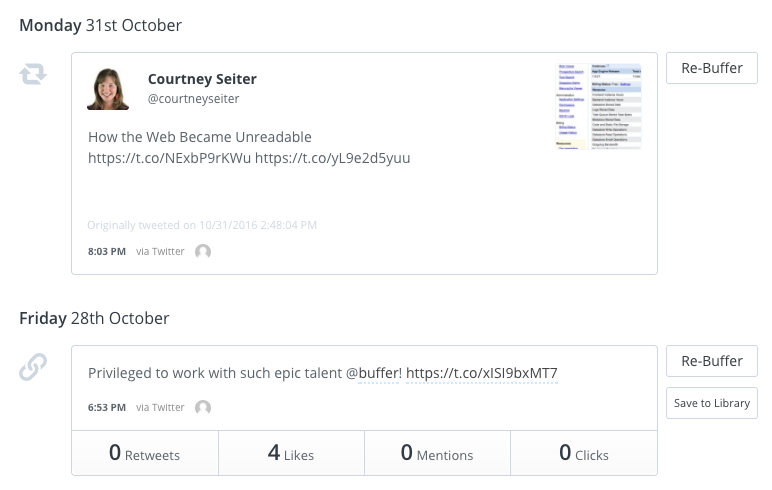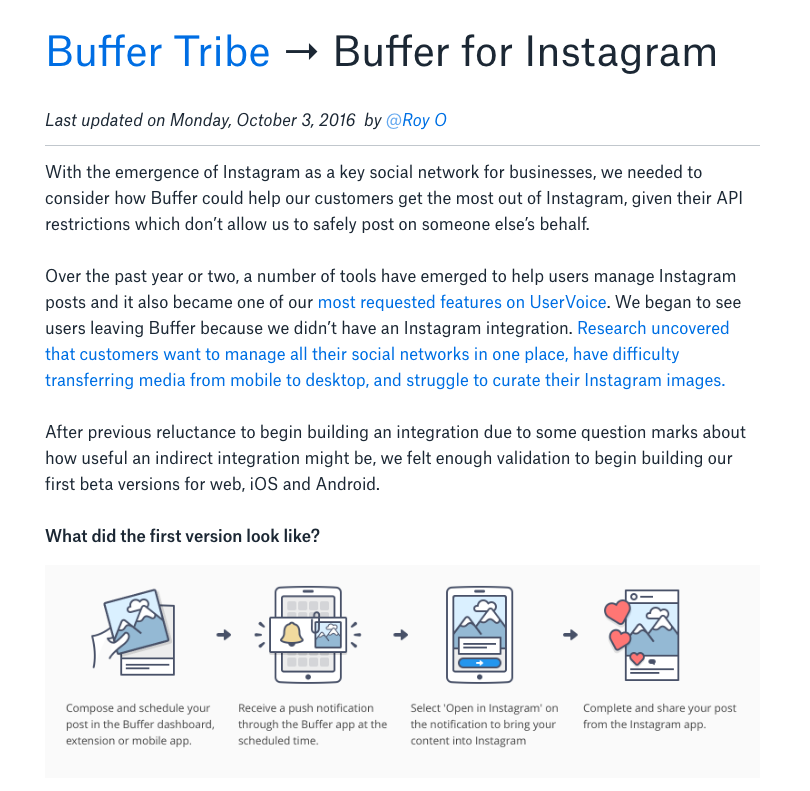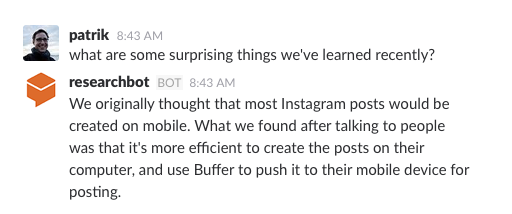
Coming Soon: Instagram Grid Preview, Facebook Page Tagging and More
Weekly active Awesome + Individual plan users
167,987 +1.7%
Weekly active
Buffer for Business users
4,945 +1.8%
Buffer for Business
Monthly Recurring Revenue
$500,161 +5.6%
Social updates sent by
Buffer for Business
users
3,273,927 +9.2%
Users starting
Buffer for Business
trials in September
6,234 +1.32%
Converted
Buffer for Business
trials
412 +1.72%
Individual + Awesome update: Instagram reposting is live!
Update by Suprasanna Mishra
Introducing Instagram reposting!
In October, we launched Instagram Reposting through Buffer!
You can now copy a URL for Instagram (or any link at all!) and when you visit the Buffer app, you’ll see a quick banner that asks if you want to repost the Instagram or share the link. You can then tap on it and add it to your queue or repost it right away.

Next up for Instagram: a grid preview feature!
We discovered through our customers that many Instagram marketers and brands pay a lot of attention to the aesthetics of their Instagram grid. However, it’s tough to predict in advance what your grid might end up looking like if you have multiple upcoming posts you’d like to share.
We hope to make this easier by letting you preview your future Instagram grid from within Buffer!
We started customer development for the grid preview in October, then worked through a few different early concepts and started zooming in on the details. More to come next month!
Building and perfecting the new composer experience
As a continuation of last month’s efforts on the new composer experience, we spent this past month in building mode to get the extension version of the new composer closer to ready for deployment!
In October, we looped back on fixing a lot of bugs and friction points we had identified and focused on getting everything done around link attachments, link previews and media attachments.
In November, we hope to have all the major pieces in the new composer and then use December for final quality assurance and testing!
Buffer for Business update: New admin system, Facebook Page tagging coming soon
Update by Tom Redman
New admin rolling out in November
Our new Organization Admin tool is complete and set to roll out in the first week of November!
This tool provides an intuitive, streamlined way to manage your team, posting permissions, and social accounts in one place. I’m incredibly proud of the team who’ve worked so hard to put this together over the past months, and we’re all very excited to be able to finally share this new tool with you!
Coming soon: Facebook Page tagging
One feature that our customers have asked for is Facebook Page tagging, which would allow you to mention other Facebook Pages from your own Facebook Page, directly within Buffer!
We’re happy to share that this feature is next on our list! As our new organization admin rolls out, we’ll start development for Facebook Page tagging, which should be available alongside our new “Multiple Composers” feature.
Removing analytics for retweets
On the Analytics front, we’ve made a few minor changes, while continuing to focus on some bigger adjustments this quarter.
One such change was removing the “quick analytics” view for retweets, which was a bit confusing since the numbers could often be very, very high.
For example, if you retweeted President Obama, the quick analytics might suggest your retweet got 10,000 likes, when really, those likes belong to the president! Here you can see an example of this change in my own analytics feed, showing when I retweeted my teammate Courtney, and just below that, my own Tweet:

Collaboration Tool in development
The first phase of development for our new Collaboration Tool is well underway.
This phase is scheduled for release this quarter, and includes the ability for both Managers and Contributors to create drafts (and Manager’s can then approve them!).
This will be accomplished with an improved, freshly designed flow which we hope will make the process of working with your team a lot more intuitive. The second phase of this project will add history, comments, and internal mentions to these drafts!
Growth update: Awesome experiments, Business plan growth
Update by Maxime Berthelot and Tom Dunn
Numbers from 7-day Awesome trial look… awesome!
As we shared last month, we ran an experiment in August where 50% of customers signing up from Buffer.com were immediately put on a seven-day Awesome plan trial.
As a result, we had 24,500 customers starting an Awesome trial in August (compared to a monthly average of about 3,100.)
Though this experiment ended in August, we’re still seeing its residual effects. It resulted in 1,038 conversions in September, compared to 736 in October. (This number will increase over the next few days as we always observe a lot of conversions a few days after the end of a trial.)
It’s interesting to correlate this drop-off with the total number of Awesome customers added in October (4,891, which is -0.93% compared to September.)
While the effect on net monthly recurring revenue (MRR) is not quite statistically significant, there are significantly more customers on Buffer for Business plans in the trial group.
With this data, we feel confident pushing the 7-day Awesome trial for 100% of users.
However, our data for this experiment has changed as users have had more time to upgrade, downgrade, and churn. It seems like we’re seeing the users normalize a bit into the plans that they may have otherwise chosen without the full option trial.
We will keep a close eye on the data to monitor longer-term effects on retention and churn also.
The results of our “double price” experiment
As we shared in September, the price of the Awesome plan has remained at $10 a month for two years now, despite adding a lot of value and features since then.
With the amount of inflation and added value to the Awesome plan, we feel it’s well worth a slightly higher price.
To test this hypothesis on a small control group, we showed a portion of our new signups a price of $20 per month for a few weeks in September.
We ran this experiment for 12 days and showed 18,000 users the $20 monthly price.
Customers in the control group (who saw our $10 Awesome plan) generated $4,800 in net MRR. Customers in the enabled group (who saw the new $20 Awesome plan) generated $4,000 in net MRR.
Looking at the significance for net MRR and average net MRR per signup for both groups suggests that doubling the price of the Awesome plan does not make a significant positive impact on revenue gained.
We plan to send everyone who upgraded in the $20 group (221 customers in total) a refund along with an email explaining their reduction. The total refund amount is $7,600, so we’ll see a small dent in MRR at the end of the week.
Despite the fact that this experiment wasn’t a “success” in the traditional sense, we’re really encouraged by the learnings so far.
When we decided on a $20 price point, we mainly did it based on our gut. We’re happy now to have two data points (for $10 and $20) to help us predict the price for our future pricing experiments.
Collaborating with the data team to answer tough questions
Having great data tracking in place is key for a growth team and at Buffer we’re lucky to have an amazing team of data analysts who help us learn from data every day. Julian (a fantastic data analyst) has been helping us a lot over the past 2 months with experiment design and data analysis, which has given us much more confidence in our A/B tests.
On the technical side, we have a lot to improve on with the way we track and collect data and still have grey areas when trying to track user paths on Buffer. There are lots of questions we are determined to answer, like:
- What’s the average number of times a visitor comes to the blog before signing up?
- What’s the most successful upgrade path to Awesome?
- Is it possible to break down MRR by upgrade paths?
To get answers to these questions, we need a solid internal and external tracking system. The growth team is happy to collaborate closely with the data team this quarter to make that possible.
If you have any experience or advice with tracking systems like this, we would love to learn from you!
Research update: Asking better questions through Jobs to be Done framework
Update by Patrik Ward
Exploring the Jobs to be Done framework
This month has been an exciting one for the research team as we’ve started working closely with the design team to integrate the Jobs to be Done framework into our process.
Jobs to be Done has this formula as its central thesis:

This framework provides us with additional tools and questions as researchers in order to understand the primary reason that people are using Buffer. It also gives us a powerful view into the workflows that people are using so we can think about solutions that fit into existing habits more easily.
We’re still quite early in exploring this framework and understanding how to apply it to get the best understanding of customer problems. We’ll be excited to share more about our experience using Jobs to be Done and integrating it with the other research frameworks that we’re using, such as customer development and usability testing.
Scaling our knowledge by sharing the Research Library
When we first started doing deliberate product research at Buffer, we had far more questions than answers. How are people using the features that we’ve built? How can we figure what the best thing to build is?
Fast forward a couple of years and we still have many questions. But we also have quite a few learnings that we’ve uncovered through hundreds of interviews (and even more surveys and experiments).
One of our product researchers, Mike Eckstein, recently shipped an internal tool to help us share what we’ve learned. We call it the Research Library. Here, Buffer teammates can find summaries of key information on each feature/element of Buffer that we’ve researched, adding up to a condensed “story” version of what we’ve learned.

An early version of the Research Library.
We launched the Research Library at the beginning of October and so far about 32% of the team has used it. We’ve also started working on a Slackbot that would provide another way for the team to interact with this knowledge, in addition to acting as a resource for team members in far-flung time zones who may not have much overlap with the research team.

These are both experiments that are still very much in the early stages, so we’re excited to continue improving them and providing more value to the Buffer team!
Over to you!
Did anything stand out to you in this report? Any questions for any of our team members? We’d love to hear from you in the comments!
Check out more reports from October 2016:
Try Buffer for free
140,000+ small businesses like yours use Buffer to build their brand on social media every month
Get started nowRelated Articles

Note: This is the quarterly update sent to Buffer shareholders, with a bit of added information for context. We share these updates transparently as a part of our ‘default to transparency ’ value. See all of our revenue on our public revenue dashboard and see all of our reports and updates here . It's been quite the y

Editor’s Note: Thanks for checking out this post! We’ve released our updated 2021 pay analysis here. You can’t improve something if you don’t know that it needs to be improved. That was very true for us four years ago when we first started looking into equal pay at Buffer. We have long used a salary formula to determine all of our salaries – the same role in the same part of the world receives the same salary. That m

Ever since the world got turned upside down by COVID-19, it’s been “business as unusual” for everyone – Buffer included. I sent this update out to Buffer’s investors one week ago. I hesitated on whether to share it more widely, as I know a lot of companies have been impacted more severely in these times. That said, I believe it makes sense to lean into our company value of transparency, since there may be some companies this could help, and it shows Buffer customers that we will be around beyon
